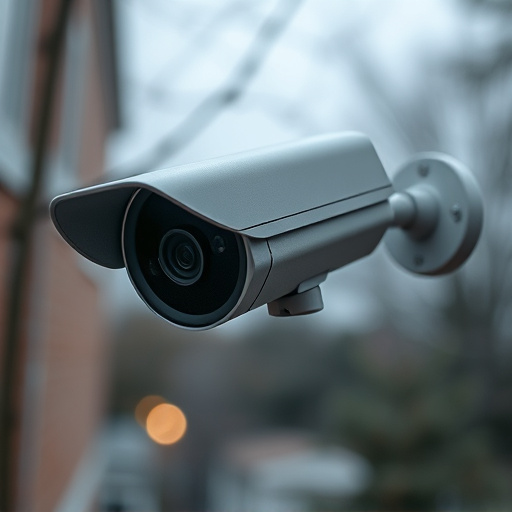To mount fake security cameras effectively, first assess your business's needs and constraints, positioning them strategically for optimal coverage while maintaining discretion. Choose durable, weather-resistant cameras with realistic features for authenticity. Utilize sturdy, outdoor-rated brackets or mounts, securing them firmly to withstand adverse conditions and theft attempts, ensuring clear, reliable surveillance.
Weatherproof fake cameras are an effective deterrent for theft and vandalism, offering businesses enhanced security. This guide explores how to maximize their impact. We delve into understanding specific weatherproof requirements for these cameras, choosing optimal locations for mounting, selecting durable and realistic models, and securing them through robust installation techniques. By following these steps, you’ll ensure your fake security cameras provide both visual deterrence and reliable performance in any environment. Learn how to mount fake security cameras effectively for superior business protection.
- Understanding Weatherproof Requirements for Fake Cameras
- Choosing the Right Location for Mounting Fake Security Cameras
- Selecting Durable and Realistic Fake Camera Models
- Securing Cameras: Techniques for Robust Installation
Understanding Weatherproof Requirements for Fake Cameras
When considering weatherproof fake cameras for business use, understanding your specific mounting needs and environmental conditions is crucial. Different businesses have varying requirements; some may need to mount cameras outdoors, exposing them to harsh weather conditions like rain, snow, and extreme temperatures. In such cases, selecting a camera with an IP rating (a measure of protection against solids and liquids) higher than 65 is essential. This ensures the camera is protected against powerful water jets and can withstand environmental factors like dust and moisture.
Knowing how to mount fake security cameras properly is also vital. Secure mounting prevents theft or damage, ensuring optimal performance in adverse weather conditions. Cameras should be mounted at a suitable height, offering clear visibility without obstructing natural light or line of sight. Using sturdy brackets or mounts designed for outdoor use, and securing them with strong hardware, will ensure the camera’s longevity. Regular maintenance, including cleaning and sealing, can further protect against moisture ingress and corrosion, enhancing the camera’s weatherproof performance over time.
Choosing the Right Location for Mounting Fake Security Cameras
When mounting fake security cameras, understanding your business’s unique needs and constraints is crucial. Identify high-risk areas that require surveillance, such as entrances, exits, or valuable merchandise zones. Consider factors like lighting conditions—both natural and artificial—as well as potential obstacles like trees or signage that might obstruct the camera’s view.
To effectively How to Mount Fake Security Cameras, position them strategically for maximum coverage. Ensure they are at eye level or slightly elevated to capture clear footage of individuals and vehicles. Conceal the cameras subtly within the environment, using mounting hardware designed to blend in, like those used for real security systems, to avoid drawing unwanted attention.
Selecting Durable and Realistic Fake Camera Models
When choosing weatherproof fake cameras for business security, selecting durable and realistic models is paramount. Opt for cameras designed with robust materials that can withstand harsh weather conditions, ensuring they don’t become a target for theft or damage themselves. Realistic features like detailed textures, authentic colors, and precise lens simulations make these fake cameras nearly indistinguishable from the real thing, deterring potential intruders while maintaining an unobtrusive presence.
Consider how you plan to mount your fake security cameras as part of your selection process. Different mounting options—from wall mounts to pole installations—require specific camera designs tailored for stability and secure attachment. Weatherproof models often come with versatile mounting brackets designed to adapt to various environments, ensuring a seamless integration into your business’s security system without compromising durability or realism.
Securing Cameras: Techniques for Robust Installation
Mounting fake security cameras correctly is a critical step in ensuring their effectiveness as deterrents and for business surveillance. When installing these devices, it’s essential to consider environmental factors and choose appropriate mounting techniques. One effective method is using sturdy brackets or mounts designed specifically for outdoor use, which can be fixed to walls, ceilings, or poles. These brackets should be made from weather-resistant materials like aluminium or stainless steel to prevent rust and corrosion.
For optimal positioning, consider using adjustable mounts that allow for flexible placement. This flexibility enables you to direct the camera’s view precisely where needed, enhancing coverage without unnecessary overlap or blind spots. Additionally, ensuring the cameras are securely fastened with sturdy screws and anchors tailored to the mounting surface is vital to withstand adverse weather conditions and prevent theft.
When implementing weatherproof fake cameras for business, understanding your environment, selecting the right equipment, and securing installations are key. By choosing durable models that mimic real cameras and employing robust mounting techniques, you can create an effective security system that deters criminals without breaking the bank. Remember, proper placement and secure attachment are vital to ensuring these cameras stand up to various weather conditions, providing reliable surveillance for your business’s safety. For a successful setup, follow best practices outlined in this guide, including understanding your location’s specific needs and selecting the perfect fake security camera models.
